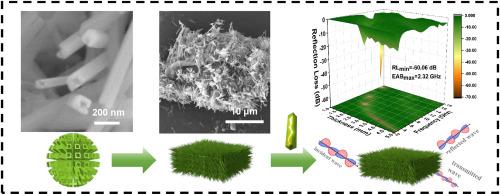通过界面工程和控制MnO2形态,实现MXene/MnO2复合材料的协同微波吸收
IF 9.7
2区 材料科学
Q1 MATERIALS SCIENCE, MULTIDISCIPLINARY
引用次数: 0
摘要
二维金属碳化物Ti3C2Tx MXene是一种很有前途的电磁污染防护材料。多层MXene具有独特的手风琴状结构,通过延长入射电磁波的衰减路径,提供了作为微波吸收剂的天然优势。本研究通过“氢离子浓度-温度”两参数协同策略实现了MnO2形态的可控生长,并结合MXene的层间界面工程构建了具有协同吸波效果的复合结构。通过对氢离子浓度和水热温度的精确控制,可以获得形貌各异的二氧化锰柱。与纯多层MXene或MnO2相比,所有复合材料系列的微波吸收性能都明显优于纯多层MXene或MnO2,这突出了组件设计和结构协同在增强电磁波吸收(EWA)中的关键作用。值得注意的是,含有较大孔径的空心方形二氧化锰柱的复合材料表现出最佳的性能,这归因于最大的电子传递加速度。该复合材料在16.64 GHz时的最小反射损耗(RLmin)为-60.04 dB,超薄厚度仅为1.0 mm。基于微观损失机制,全面讨论了复合材料系列中EWA性能的变化。本研究为从结构工程角度设计高性能mxene微波吸收器开辟了新的途径。本文章由计算机程序翻译,如有差异,请以英文原文为准。

Synergistic microwave absorption in MXene/MnO2 composites achieved through interfacial engineering and controlled MnO2 morphology
Two-dimensional metal carbide Ti3C2Tx MXene has emerged as a promising material for electromagnetic pollution protection. Multilayered MXene, featuring a unique accordion-like structure, offers a natural advantage as a microwave absorber by extending the attenuation path of incident electromagnetic waves. In this study, the controlled growth of MnO2 morphology is achieved by the two-parameter synergistic strategy of ‘hydrogen ion concentration-temperature’, and the composite structure with synergistic wave-absorbing effect is constructed by combining the interlayer interfacial engineering of MXene. By precisely controlling hydrogen ion concentration and hydrothermal temperature, MnO2 pillars with distinct morphologies were achieved. All composite series exhibited significantly superior microwave absorption performance compared to pure multilayered MXene or MnO2, highlighting the crucial role of component design and structural synergy in enhancing electromagnetic wave absorption (EWA). Notably, the composite incorporating hollow tetragonal MnO2 pillars with larger apertures demonstrated optimal performance, attributed to maximized acceleration of electron transport. This composite achieved a minimum reflection loss (RLmin) of -60.04 dB at 16.64 GHz with an ultra-thin thickness of only 1.0 mm. The variations in EWA performance across the composite series are comprehensively discussed based on their microscopic loss mechanisms. This study paves a new avenue for designing high-performance MXene-based microwave absorbers through structural engineering.
求助全文
通过发布文献求助,成功后即可免费获取论文全文。
去求助
来源期刊

Materials Today Physics
Materials Science-General Materials Science
CiteScore
14.00
自引率
7.80%
发文量
284
审稿时长
15 days
期刊介绍:
Materials Today Physics is a multi-disciplinary journal focused on the physics of materials, encompassing both the physical properties and materials synthesis. Operating at the interface of physics and materials science, this journal covers one of the largest and most dynamic fields within physical science. The forefront research in materials physics is driving advancements in new materials, uncovering new physics, and fostering novel applications at an unprecedented pace.
 求助内容:
求助内容: 应助结果提醒方式:
应助结果提醒方式:


